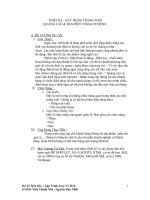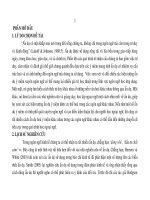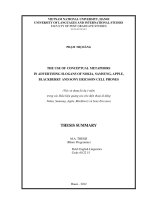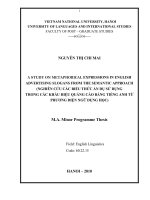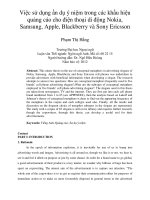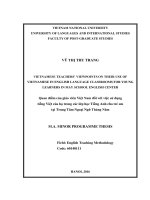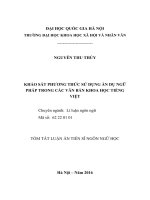Việc sử dụng ẩn dụ ý niệm trong các khẩu hiệu quảng cáo cho điện thoại di động Nokia, Samsung, Apple, Blackberry và Sony Ericsson
Bạn đang xem bản rút gọn của tài liệu. Xem và tải ngay bản đầy đủ của tài liệu tại đây (213.77 KB, 14 trang )
Việc sử dụng ẩn dụ ý niệm trong các khẩu hiệu
quảng cáo cho điện thoại di động Nokia,
Samsung, Apple, Blackberry và Sony Ericsson
Phạm Thị Hằng
Trường Đại học Ngoại ngữ
Luận văn ThS ngành: Ngôn ngữ Anh; Mã số: 60 22 15
Người hướng dẫn: Dr. Ngô Hữu Hoàng
Năm bảo vệ: 2012
Abstract: This minor thesis on the use of conceptual metaphors in advertising slogans of
Nokia, Samsung, Apple, Blackberry and Sony Ericsson cell phones was undertaken to
provide advertisers with beneficial information when developing a slogan. The research
attempts to answer two questions: How are conceptual metaphors frequently used in five
brands’ cell phone advertising slogans?;What are the subtypes of conceptual metaphors
employed in five brands’ cell phone advertising slogans?. The slogans used in this thesis
are taken from newspapers, TV and the internet. They are first put into each cell phone
brand numbered from 1 to 65 (see APPENDIX), then the analysis based on Lakoff and
Johnson’s theory of conceptual metaphors is done to find out the appearing frequency of
the metaphors in the corpus and each subtype used also. Finally, all the results and
discussion on the frequent choice of metaphor subtypes in the slogans are represented.
The study with a corpus of 65 slogans is still on its infancy and requires further research,
though the copywriters, through this thesis, can develop a useful tool for their
advertisements.
Keywords: Tiếng Anh; Quảng cáo; Ẩn dụ ý niệm
Content
PART I: INTRODUCTION
1. Rationale
In the epoch of information explosion, it is inevitable for any of us to bump into
advertising words and images. Advertising is all around us, though we like it or not, we hear it,
see it and feel it albeit on purpose or just by some chance. In order for a brand name to go global,
a good advertisement of their product is a key matter, no wonder why billions of bugs has been
spent on copywriting. The utmost aim of the advertisement is to capture our attention. “The
whole aim of the copywriters is to us get us register their communication either for purposes of
immediate action or to make us more favourably disposed in general terms to the advertised
product or service. […] so copywriters have to find ways to shout at us from the page.” (Angela
Goddard, 1998: 11).
The researcher is also captive in advertisements especially those of mobile phones. That
is the reason why I took a hook to go ahead with mobile phone advertising slogans.
In order to achieve the aim of getting customers noticed, copywriters have contributed a
non-stop effort in creating an attractive, memorable, distinct advertising slogans for each brand.
The methods used in writing advertising slogans range from employing phonological aspect,
lexical and morphological aspect, syntactic aspect to semantic aspect. More concretely, in
phonological aspect, rhyme, homophone, alliteration are often put into consideration while in
lexical and morphological aspect, verb phrase, noun phrase, collocation, idiomatic construction,
formation of new words and phrases are of great approval. What’s more, when syntactic aspect
can be found in sentence types, sentence structure like ellipsis, semantic aspect is often realized
through rhetorical devices such as simile, hyperbole, metonymy, polysemy and metaphors. The
researcher is absolutely engaged in metaphors which have long been a part of my interest. This
explains the second reason to choose metaphors in advertising.
Metaphors are a part and parcel of everyday life in that they appear in nearly all our
everyday concepts without our realization of it. Lakoff and Johnson give the notion of
conceptual metaphors which have explained this all in an easy-understanding way. This
attributes to the cause for choosing Lakoff and Johnson’s theory as a foundation in analyzing the
data obtained in the study.
2. Objectives of the study and the research questions
The study tries to seek out the answers to two research questions.
Research question 1: Are conceptual metaphors frequently used in five brands’ cell phone
advertising slogans?
Research question 2: What subtypes of conceptual metaphors are employed in five brands’ cell
phone advertising slogans?
3. Scope of the study
Due to the time constraint, the thesis only focuses on five cell phone brands’ slogans
which are world famous ones.The selected slogans of five brands are randomly taken from
newspapers, TV and Internet at the researcher’s ease.A corpus of 65 chosen slogans is not a big
one, so to some extents, the results provided are just selective, not comprehensive.
In this study, the analysis is based on the theory and classification of metaphors given by
Lakoff and Johnson.
4. Method of the study
This research is a combination of primary and secondary research. More specifically, it is
firstly a secondary research in that there is a literature review of metaphors study as well as
metaphors in advertising provided; it is secondly a primary research in that the researcher uses
statistical research method in order to give a description of a language phenomenon occurring in
advertising slogans of five mobile phone brands. In addition, the exploratory research method is
employed with an aim to examining the correlations among three subtypes of conceptual
metaphors namely structural, ontological and orientational metaphors.
5. Design of the study
The study consists of three parts: INTRODUCTION, DEVELOPMENT including two
chapters and CONCLUSION.
CHAPTER II: LITERATURE REVIEW
1. Definition of metaphors
An enormous effort has been made in the course of finding a way to define what
metaphor is by many scholars and researchers all around the world. Gibbs (1999:29) even
introduced an ironical statement by Wayne Booth that by the year 2039 “there would be more
students of metaphor than people” (quoted in Michael White, Estudios Ingleses de la
Universidad Complutense, Vol.10 (2002) 309-315).
Kovecses, one of the most significant Hungarian researchers of metaphors gave out his
definition as follows:
In the cognitive linguistic view, metaphor is defined as understanding one conceptual domain in
terms of another conceptual domain […]. The conceptual domain from which we draw
metaphorical expressions is to understand another conceptual domain called source domain,
while the conceptual domain that is understood this way is the target domain […].
Understanding one domain in terms of another involves a set of fixed correspondences
(technically called mappings) between a source and a target domain (2002: 4) (quoted in Agnes
(2009:20))
All definitions have in common that they speak of two terms related to each other thanks
to the similarities they have. But they also limit the function of metaphors to embellish or
decorate the language.
In their work, Lakoff and Johnson (1980:3) said:
Metaphor is for most people a device of the poetic imagination and the rhetorical flourish – a
matter of extraordinary rather than ordinary language. Moreover, metaphor is typically viewed
as characteristic of language alone, a matter of words rather than thought or action. For this
reason, most people think they can get along perfectly well without metaphor. We have found, on
the contrary, that metaphor is pervasive in everyday life, not just in language but in thought and
action. Our ordinary conceptual system, in terms of which we both think and act, is
fundamentally metaphorical in nature.
By what they found, Lakoff and Johnson indicated that metaphors not only influence our
“linguistic behavior but also our thought processes and our system of value.” (cited in Ágnes,
2009: 21)
2. Conceptual metaphors
Lakoff and Johnson introduced the notion of conceptual metaphors in Metaphor we live
by (1980) with some famous metaphors like LOVE IS A JOURNEY, ARGUMENT IS WAR,
HAPPY IS UP. Black also gave a metaphor MAN IS WOLF (Black, 1955:286) which as our
first glance resembles the structure of conceptualization given by Lakoff and Johnson. However,
in his work, Black did not give out two terms target and source domain, instead he called MAN
and WOLF two subjects: the principle subject (MAN) and the subsidiary subject (WOLF), then
he tried to suggest a set of standard believes about wolves that are the common possession of the
members of some speech community from which we note that wolves refer “to something fierce,
carnivorous, treacherous”, hence man “preys upon other animals” and is “fierce, hungry,
engaged in constant struggle, a scavenger” (Black, 1995:287). Black called the similarities
between MAN and WOLF “the commonplaces” and the “corresponding system” (1995:288).
From Black’s analysis of his metaphor, we can see that the notion of conceptual metaphor had
been conceived long ago, before the introduction of Lakoff and Johnson.
To give some ideas of what it could mean for a concept to be metaphorical and for such a
concept to structure an everyday activity, Lakoff and Johnson started with the concept
ARGUMENT and the conceptual metaphor ARGUMENT IS WAR which is reflected in our
daily language by a wide variety of expressions.
ARGUMENT IS WAR
Your claims are indefensible.
He attacked every weak point in my argument.
His criticisms were right on the target.
I demolished his argument.
I’ve never won an argument with him.
You disagree? Okay, shoot!
If you use that strategy, he’ll wipe you out.
He shot down all of my arguments.
(Lakoff and Johnson, 2003:5)
3. Classification of conceptual metaphors
Lakoff and Johnson (2003) classified conceptual metaphors into three different kinds,
namely structural metaphors, orientational metaphors and ontological metaphors. Kovecses
(2010), despite having three other criteria for categorizing conceptual metaphors, had the same
classification as Lakoff and Johnson, regarding cognitive function of metaphors.
3.1. Structural metaphors
In this kind of metaphors, “the source domain provides a relatively rich knowledge
structure for the target concept” (Kovecses, 2010:37). In other words, the cognitive function of
these metaphors is to enable speakers to understand target A by means of the structure of source
B. This understanding occurs by means of conceptual mappings between elements of A and
elements of B.
For example, in the metaphor: LOVE IS A JOURNEY, the target domain LOVE is
understood via the source domain JOURNEY through a range of mappings. The mappings
include:
LOVE IS A JOURNEY
Look how far we’ve come
We are at the crossroads
We’ll just have to go our separate ways. We can’t turn back now.
- Lovers corresponds to Travelers
- The relationship between lovers corresponds to the means of transportation (the vehicle)
- The means for achieving purposes correspond to routes.
3.2. Ontological metaphors
It is necessary to make the concept of ontology well-defined in assistance to
understanding ontological metaphors. Ontology is traditionally listed as a part of the major
branch of philosophy known as metaphysics, which “deals with questions concerning what
entities exist or can be said to exist, and how such entities can be grouped, related within a
hierarchy, and subdivided according to similarities and differences”
(www.wikipedia.org/wiki/ontology). Kovecses (2010: 38) also read “ontology is a branch of
philosophy that has to do with the nature of existence”.
Ontological metaphors base on our experiences with physical objects, that is “ways of
viewing events, activities, emotions, ideas, etc as entities and substances.” (Lakoff and Johnson,
2003: 26). By this way, when the target domain is not discrete or bounded, we can still
categorize and identify them. There are many kinds of ontological metaphors with different
purposes one of which being the concept ABSTRACTS ARE THINGS:
An accumulation of problems.
The solution was within rich.
The joy was seen in his face.
In these examples, by setting an artificial boundary, we can bound the “problems”,
“solution”, and “joy” in a way that we can see it, can touch it.
3.3. Orientational metaphors
As the name suggests, those metaphors are based on the orientation in space, hence a
special relationship is made for a concept. This relationship is normally based on our experiences
of the physical space we possess.
For instance,
Being HAPPY IS HIGH/UP
Being SAD IS LOW/DOWN.
4. Metaphors in advertising slogans
4.1. Definition of an advertising slogan
There is a countless number of definitions given to advertising which all have in common
that advertising is a means of promoting the product, idea or organization on the market with an
aim to giving information and to persuading people of the benefits of the product and inducing
them to take an action, say to buy it, to approve of it, to follow it, etc.
Advertising slogan is defined as “a word or phrase that is easy to remember, used for
example by a political party or in advertising to attract people’s attention or to suggest an idea
quickly” in Oxford Advanced Learner’s Dictionary 2001 (Jana Lapsanska, 2006: 14). However,
Greg Meyers (1997) use the term “slogan” in broader sense – for any catchy phrase. Slogan is
“…the backbone of the whole campaign, helping the other party to memorize the product being
advertised” (Mgr. Jana Pelclová, 2010: 30). In the frame of this thesis, the concept “slogan” will
be understood in a large sense which means slogan is any catchy words or phrases or even
sentences used in an advertising campaign of a product.
4.2. Conceptual metaphors in advertising slogans
The application of metaphors in advertising has aroused close attention of many scholars
and researchers around the world. Lapsanska wrote, “a single metaphor may be worth of a
hundred words of advertising text. It has an interesting value and stimulates the curiosity of the
reader about the product” (2006: 46). Czerpa saw eye to eye with Lapsanska when she noted that
metaphors in advertisements are powerful and compelling tool because they not only enrich an
add but also extend the meaning of textual/ visual message, creating multi-leveled layers of
interpretation (Czerpa, 2006: 3). MacInnis, Moorman and Jaworski (1991) viewed metaphor as
“a stimulus of deeper levels of processing because of its interest value and because it stimulates
curiosity about the product or brand” (Czerpa, 2006: 4).
Nissan advertises their car with the slogan “Change to new ways” which embeds in it the
conceptual metaphor LIFE IS A JOURNEY and Nissan will bring you to a better future. Let’s
have another look at the advertising slogan of Macy’s perfume: “Feast your senses” or “Make
them [men] melt” through which we can see the adoption of SEXUAL DESIRE IS HUNGER
metaphor and AFFECTION IS WARMTH respectively. Also, the mappings of PASSION IS
HEAT can be found in Lancôme’s lip gloss slogan “Color fever gloss”.
Orientational metaphor GOOD IS UP is seen in the ad “Beyond and above” – Land Rover
cars range, “Built from the cloud up” – Microsof Window Server 2012, “spice things up” –
Macy’s perfumes, “Life can’t wait. Change up your look. Change up your life.” – Sunsilk
Shampoo. Or in “Up your status” – Samsung cell phone, we can find the orientational metaphor
HIGH STATUS IS UP.
CHAPTER III: THE USE OF METAPHORS IN CELL PHONE
ADVERTISING SLOGANS
1. Procedures
1.1. Data collection
A list of 65 cell phone advertising slogans are chosen at random from online newspapers,
TV ads and websites.
These 65 slogans are classified into 5 cell phone brand names: Nokia, Samsung, Apple,
Blackberry and Sony Ericsson.
The researcher chose these 5 bands for the reason that they are well-known and
prominent in everyday use. Further more, the source to collect data is at hand.
2.2. Data analysis
All these slogans will be first sorted out into categories of brand names, then analyzed to
show whether they use metaphors or not. The next step is to study the metaphors employed in
each slogan so that the researcher can point out to which categories of conceptual metaphors
namely structural, ontological and orientational the slogans belong. In order to achieve that
purpose, the qualitative method is to be used. After that, the quantitative method is adopted with
an aim of figuring out the proportion of three kinds of conceptual metaphors in these selected
slogans. Finally, a description of the results will be presented through the statistics and
interpretation.
2. Results and discussion
2.1. Research question 1: The frequency of the use of conceptual metaphors in cell phone
advertising slogans
Chart 1: The use of metaphors in cell phone advertising slogans.
51/65 metaphors are used in mobile phone advertising slogans. Such a figure is not minor
as metaphor is just one among many types of linguistic means used in advertisements.
In her findings, Lapsanska (2006:76) showed that 99/270 metaphors are used in advertisements
(including personification as one subtype of ontological metaphors), which is equivalent to 37%
while the percentage of metaphors applied in cell phone advertising slogans accounts for 78%,
doubling that of Lapsanska’s result. This reveals that metaphors appear with high frequency in
mobile phone advertisements. Maybe the reason for this had been stated by Kovecses “An
appropriately selected metaphor may work wonders in promoting the sale of an item”. (2002:59).
2.2. Research question 2: Types of conceptual metaphors used in mobile phone advertising
slogans
The use of metaphors in cellphone advertising slogans
78%
22%
use metaphors
not use metaphors
Chart 2: Subtypes of conceptual metaphors used in cell phone advertising slogans
It is clear from the pie chart that the ontological metaphors are found in cell phone
advertising slogans with the highest frequency, making up 63% off all three subtypes.
In analyzing ontological metaphors, it is noted that personification is used very widely in
the selected slogans. In these slogans, PRODUCT IS A PERSON WITH HUMAN
CAPACITIES.
For example, Nokia cell phone is a person who can connect people together (Connecting
people – slogan (1), see APPENDIX). The same thing occurs in slogan (30) “No matter how you
stay in touch, Samsung connects you in style” or “Connect to what matters” (slogan (55)).
Further more, Samsung cell phones have the ability of inviting people (Everyone’s
invited – slogan (16)), saying (The right thing says everything – slogan (23)), feeling happy
(Download some mobile music. It’ll make your phone happy – slogan (24)).
Apple can say hello to you (Slogan (34), see APPENDIX), listen to you (“Say Hello to
iPhone” – slogan (36)), can beat (The first phone to beat the iPhone – slogan (39)), can change
your life (“This changes everything. Again” – slogan (44)).
Blackberry phones are also human beings in that they can fuel you with power, express
your style and simplify your life (Power the passions you pursue with a smartphone that
expresses your style and simplifies your life – slogan (56)).
Also, ABSTRACTS ARE THINGS ontological metaphor are found in these slogans, the
entailments of this ontological metaphor can be traced in:
EXPERIENCES ARE THINGS (Blackberry – Bring experiences to life! – slogan (50));
SUCCESS IS AN OBJECT (Nokia – Get a taste of success – slogan (15));
AMAZING IS AN OBJECT (Samsung – A touch of amazing – slogan (21));
BEAUTY IS AN OBJECT (Samsung – Imagine touching beauty – slogan (27));
Subtypes of conceptual metaphors used in cellphone advertising slogans
63%
29%
8%
ontological metaphors
structural metaphors
orientational metaphors
LIFE IS AN OBJECT (Blackberry – Find more life – slogan (53)).
In slogan (7) “Hit a hole-in-one. Hit the right impression”, we can notice two conceptual
metaphors: THE PHONE IS A GOLF CLUB (structural metaphor) which you can use and hit the
ball to the hole, and IMPRESSION IS AN OBJECT (ontological metaphor), so you can hit it.
Slogan (13) “Connect with style” also embeds the ontological metaphor ABSTRACTS
ARE THINGS, specifically STYLE IS AN OBJECT.
“Your life. Enhanced” also offers the ontological metaphor LIFE IS A PRODUCT in
here, A MOBILE PHONE, the audience are expected to draw a message that this mobile is going
to enhance their life or in other words, improve or brighten their life.
Ontological metaphor PROGRESS IS MOTION is applied in slogan (43) “The fastest,
most powerful iPhone yet”.
Ontological metaphors are followed by structural metaphors with a percentage of 29%
which means well more than a quarter of all three subtypes. Among those, the Apple’s slogan
(33) “Touching is believing” is typical for EMOTIONAL INTIMACY IS PHYSICAL
CLOSENESS structural metaphor.
The conceptual metaphor A SOLUTION IS A PRODUCT is also realized in the slogan
“A stylish way to get things done” – Blackberry – slogan (51) or “There’s an app for that. That’s
the iPhone. Solving life’s diplemma one app at time” – Apple – Slogan (45). Moreover,
EMOTIONAL DESIRE IS PHYSICAL HUNGER is also made clear in “Wanna quench your
thirst for fun? Take a sip of Sony Ericsson Mediascape – all your music, video and photos, just
waiting to be enjoyed.” – Sony Ericsson – Slogan (64).
We can see some overlaps in the analysis between ontological and structural metaphors.
For example “A touch of amazing” can be seen as ontological and structural metaphor at the
same time. When we see AMAZING IS AN OBJECT, we are seeing it in an ontological way
that the abstract thing AMAZING do exist so that we can feel the touch of it. When we consider
the structural metaphor EMOTIONAL INTIMACY IS PHYSICAL CLOSENESS, the “touch”
(the source domain) is physically felt as an act of love and care (the target domain), thus
emotional feeling.
Moreover, when we attribute the personification metaphor to the slogan “No matter how
you stay in touch, Samsung connects you in style” we can get the ontological metaphor
PRODUCT IS A PERSON WITH HUMAN CAPACITIES because it can “connect you in
style”. However, we can also draw a structural metaphor EMOTIONAL INTIMACY IS
PHYSICAL CLOSENESS through the world “connect” because emotional intimacy is
established by physical contact, and to “connect” means to get closer.
To summarize, once again I would like to emphasize what Lakoff and Johnson concluded
in their book “Metaphors we live by”: “The division of metaphors into three types –
orientational, ontological and structural – was artificial. All metaphors are structural (in that they
map structures to structures); all are ontological (in that they create target-domain entities)
(2003: 265).
The kind of conceptual metaphors which appears with lowest frequency is orientaional
metaphors, comprising of 8%. Some of them are the realizations of the metaphor GOOD IS UP.
“Open up a world of possibilities” – Blackberry – slogan (52)
“Power up the Blackberry Curve smartphone and empower our life” – Blackberry –
slogan (58)
“The Blackberry Bold 9700 really is the pinnacle of the traditional Blackberry
smartphone experiences” – Blackberry – Slogan (57).
The message underlying these slogans is that these phones will make your life better:
Your phone can make impossible things possible, can enhance your life and it is above and
beyond any other phones, respectively.
Another orientational metaphor HIGH STATUS IS UP is also adopted in “Up your
status” – Samsung – Slogan (28). By using the metaphor, the slogan is implying that possessing
the mobile will make you climb a step in your social status.
Let’s have a look at how these metaphors are distributed in each mobile brand.
Brand names
Conceptual metaphors
Total
Ontological
Structural
Orientational
Nokia
11 (84%)
1 (8%)
1 (8%)
13 (100%)
Samsung
10 (84%)
1 (8%)
1 (8%)
12 (100%)
Apple
7 (70%)
3 (30%)
0 (0%)
10 (100%)
Blackberry
4 (49%)
3 (38%)
2 (13%)
9 (100%)
Sony Ericsson
0 (0%)
7 (100%)
0 (0%)
7 (100%)
Table 2: Proportion of three subtypes of conceptual metaphors used
in each cell phone brand.
As can be seen from the table, ontological metaphors are found mainly in the advertising
slogans of Nokia (84%), Samsung (84%) and none is found in slogans of Sony Ericsson.
Structural metaphors are the only kind exploited in all brands’ slogans. The brand with
the highest percentage of structural metaphors is Sony Ericsson (100%), next come Blackberry
(38%) and Apple (30%); the smallest shares belongs to Samsung (1%) and Nokia (1%).
Orientationl metaphors which make up the smallest share of three subtypes of conceptual
metaphors mainly focus on Blackberry with 13%. Apple and Ericsson seem to neglect this kind
of metaphors.
From the above results, we can come to a conclusion that metaphors are prevalent in cell
phone advertising slogans and ontological metaphors seem to be the very good means in
persuading and evoking customers’ actions when it is mainly employed by two big brothers in
mobile phone industry, Nokia and Samsung.
CHAPTER IV: CONCLUSION
1. Recapitulation of main ideas
The study aims at describing a linguistic phenomenon namely metaphors in advertising
slogans of cell phone advertising slogans; however, due to the time and scope limitation, it is just
a snapshot of the use of conceptual metaphors in social communication by an investigation into
advertising slogans of just five brands. After the representation of data analysis, the findings are
revealed as follows:
Firstly, conceptual metaphors is used with high frequency in advertising slogans of
Nokia, Samsung, Apple, Blackberry and Sony Ericsson mobile phone brands among other
linguistic means.
Secondly, ontological metaphors are dominant among conceptual metaphors found in
advertising slogans, making a contribution of three quarters. Structural metaphors and
orientational metaphors follow accordingly.
The research has its significance of capturing readers’ attention of the omnipresence of
metaphors in daily life in general and advertising in particular. Moreover, it is a suggestion for
copywriters to employ conceptual metaphors more in their copywriting since it has been
approved a good means by the development of famous mobile phone brands.
2. Limitations of the study
Due to the time and knowledge restriction, the researcher only collects a corpus of 65
advertising slogans of five cell phone brands. This is not a big enough corpus for us to make a
generalization of the results to advertising language in all fields.
3. Suggestions for further research
During the time the researcher carries out the thesis, many interesting ideas have emerged
and they could be the suggestions for further research.
The research can be continued as a bigger one with the description of all semantic aspects
employed in mobile phone advertising, not just metaphors. Or maybe a research into translation
of mobile phone advertising slogans from English to Vietnamese under the light of semantic
approach can be put into account. What’s more, a study of metaphors applied in all advertising
slogans world wide can be suggested.
I have worked on this thesis to the best of my ability and effort to yield the best results.
However, due to the time and knowledge limitation, mistakes are unavoidable. Thus, any of your
constructive comments, corrections or suggestions for my better job would be highly
appreciated.
References
1. English
1. Abusaeedi, A. R., Ahangar, A., Sarani, A. & Kangan, Z (2012). “The study of metaphoric
advertisements in some Iranian family journals based on conceptual blending”, International
Journal of Linguistic, 2012, Vol. 4, No. 3.
2. Agnes, A. (2009). The use of Metaphors in Advertising Argumentum, 5 (2009), 18-24.
3. Anderson E. M. (1998). The use of metaphors in online advertising, University of Florida.
4. Aristotle (1984). “Poetics”, In Collected works in 4 volums, vol. 4, M. L. Gasparov (trans.),
Moscow: Progress.
5. Black, M. (1954-55). “Metaphor”, In Proceedings of the Aristotelian Society, News series,
Vol. 55 (1954-1955, p273- 294), Blackwell Publishing.
6. Cook, G (1992) The discourse of Advertising, London, Routledge.
7. Croff, W & Cruse, D.A. (2004). Cognitive linguistics, Cambridge textbooks in linguistics.
8. Czerpa, D. (2006). “Cosmetics advertisements in the women’s magazine Elle. A comparative
study of metaphors in the Swedish and English Editions”. Linguistics in the Midnight Sun,
(Report no. 8), Lulea University of Technology.
9. Elizabeth, C. W. (2010). Structural metaphor: An exploitation of the subjective experience of
psycho-analytic essence, University of Toronto.
10. Fazio, R., Zanna, M. &Cooper, J. (1978) Direct experience and Attitude-Behavior
Consistency: An information processing analysis, Personality and Social Psychology Bulletin,
4.1, 48-52
11. Forceville, C. (1996) Pictorical metaphor in advertising, New York: Routledge.
12. Goddard, A. (1998) The language of advertising, London and New York.
13. Kovecses, Z. (2002) Metaphor: A practical introduction, Oxford University Press.
14. Lakoff, G, Espenson, J & Goldberg, A. (1991) Master metaphor list, University of California
at Berkeley.
15. Lakoff, G & Johnson, M (2003) Metaphors we live by, The University of Chicago Press.
16. Lakoff, G & Johnson, M. (1980) “The metaphorical structure of the human conceptual
system”, Cognitive Science (4), 195-208.
17. Lapsanska, J. (2006) The language of advertising with the concentration on the linguistic
means and the analysis of advertising slogans, Bratislava.
18. Leiss, W., Kline, S., and Jhally, S. (1986) Social Communication in Advertising. New York:
Methuen.
19. Michael, W. (2002) “Estudios Ingleses de la Universidad Complutense”, Vol.10, 309-315.
20. Myers, G. (1994) Words in Ads, London, Hodder Anorld.
21. Pelclová, M. J (2010) Persuasive strategies in advertising discourse. A lexico-grammatical
and socio- pragmatic analysis, Masarykova Univerzita.
22. Reck, D (2002) Understanding metaphors in everyday language, Magiste
23. Vestergaard, T & Schroder, Kim (1985) The language of Advertising. New York, Basil
Blackwell Inc.
24. Zaltman, G. & Coulter, R. H (1995) Seeing the voice of the consumer: Metaphor based
advertising research, Journal of Advertising Research, 35-50.
2. Vietnamese:
1. Bùi Thị Trang (2010) Business slogans in English and Vietnamese, VNU, ULIS, Hanoi.
2. Bùi Thị Phương Trang (2011) An investigation on metaphor used in English slogans by some
banks in the world, VNU, ULIS, Hanoi.
3. Đinh Trọng Lạc (1994). 99 phương tiện và biện pháp tu từ tiếng Việt. NXB Giáo dục.
4. Trần Văn Cơ (2011). Những khái niệm ngôn ngữ học tri nhận liên quan đến văn hóa học.
Trích sách “Ngôn ngữ học tri nhận. Từ điển”, NXB Phương Đông, Thành phố Hồ Chí Minh.
5. Lý Toàn Thắng (2005). Ngôn ngữ học tri nhận. Từ lí thuyết đại cương đến thực tiễn tiếng Việt,
NXB Khoa học xã hội, Hà Nội.
